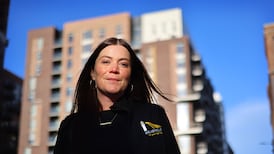The trial of two Dublin men accused of the murder of teenager Daniel McAnaspie, who was in the care of the State at the time of his death three years ago, has heard that each accused blames the other for killing him.
Richard Dekker (27) and Trevor Noone (25), both of Whitestown Avenue in Blanchardstown, have each pleaded not guilty at the Central Criminal Court to the murder of the 17-year-old at Tolka Valley Park, Blanchardstown, on February 26th, 2010.
In his opening address, Mr Brendan Grehan, SC, prosecuting, told the jury that it is the prosecution’s case that both men were involved in the stabbing of Daniel with one half of a garden sheers, inflicting injuries described as “penetrating and perforating sharp force trauma to the heart, lungs, stomach and throat areas”.
He said both accused admitted to gardaí they were present when Daniel met his death and each accused effectively say the other accused killed the teenager and that each of the accused told gardaí they were “just by-standers”.
Mr Grehan said the jury will hear evidence that Daniel was last seen alive on February 26th, 2010 at Whitestown Avenue in the company of the two accused.
He said Daniel was in the care of the HSE at Larch Cottage in Donabate, as his parents are deceased and arrangements were made with his carers to allow Daniel to meet with friends in Finglas for the day on February 25th, 2010.
“He was to meet his carers at 10pm to go back to the house he was staying at but he didn’t keep the appointment,” Mr Grehan.
He said there is no suggestion Daniel was coerced to stay out as it appears he wanted to stay out with his friends.
Counsel told the jury there will be evidence from friends of Daniel’s that they tried to persuade him to go to one of their houses at around 4am but he wanted to stay out with Dekker and Noone.
“That was the last sighting of Daniel alive,” Mr Grehan told the jury.
He said a Missing Persons investigation was launched and during the course of garda investigations, both accused were interviewed and both told gardai the last time they saw Daniel was when he was walking away from them on the night.
Mr Grehan said there will be garda evidence that Noone told gardaí it was Dekker who stabbed Daniel with half a garden sheers at Tolka Valley and that he told gardaí Dekker was “laughing” as he stabbed Daniel, while Daniel begged “Sorry, give me another chance”.
Noone told gardaí the garden sheers was shown to Daniel as he and Dekker used it in the pretence to “fight the Corduff lads”, and that Daniel went along with this.
Mr Grehan said Noone described to gardaí moving Daniel’s body in a suitcase from the Tolka Valley Park area after he was stabbed.
He also told gardaí he was under the impression Dekker was going to give Daniel a couple of slaps but then said Dekker told him he was going to stab Daniel because of an earlier altercation between Daniel and Noone.
Counsel said the jury will hear that Dekker told gardaí he was “simply there as a bystander” when Noone stabbed Daniel.
He told gardai Noone wanted to give Daniel a hiding over fighting with his cousin or uncle.
Counsel say Dekker told gardaí Noone got a garden sheers from Dekker’sgarden but that he did not think Noone “would stab Daniel – just a few slaps”.
Farmer David Mortem gave evidence he found a badly composed human remains in a ditch on his land at Rathfeigh, Co Meath on May 13th, 2010 while he was checking his potatoes and the flow of water in a ditch which was cleared out the previous year.
He said he initially thought the remains was a sheep carcass but realised it wasn’t and called gardaí.
Following dental and DNA examinations it was discovered it was the body of Daniel McAnaspie.
Mr Grehan said the prosecution cannot say which, if both, inflicted the wounds but that this does not mean that a person “gets away scott-free,” of murder.
The trial continues before Mr Justice Paul Butler and a jury of seven men and five women.










